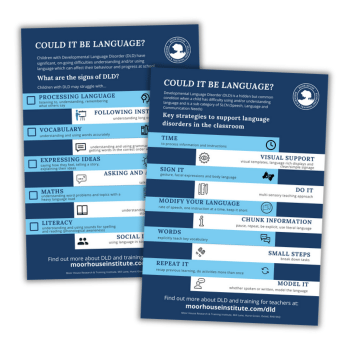Developmental Language Disorder – Strategies to try in school

We explain what Developmental Language Disorder is and how you can support pupils affected by it – while at the same time improving learning for everyone else…

- by Teachwire
- Classroom expertise and free resources for teachers

Concerned that a child in your class may have Developmental Language Disorder? We lay out what to look for and easy classroom strategies to help…
What is Developmental Language Disorder?
Developmental Language Disorder occurs when a child or adult has difficulties with talking and/or understanding language, but doesn’t have any other biomedical conditions, such as autism or intellectual disability.
These difficulties can impact on an individual’s:
- level of literacy
- ability to learn
- ability to form friendships
- emotional wellbeing
According to a 2016 study, 7% of children have Developmental Language Disorder. That means that in an average class of 30, two children may have Developmental Language Disorder.
It’s much more common than autism, yet remains a ‘hidden condition’ that’s often missed, misdiagnosed or misinterpreted as poor behaviour, poor listening or inattention.
Developmental Language Disorder can be commonly misinterpreted as a form of challenging behaviour, with a child left confused by day-to-day school rules and structures and isolated within the playground.
“In an average class of 30, two children may have Developmental Language Disorder”
According to the ‘Bercow: Ten Years On’ report, 81% of children with emotional and behavioural disorders also have significant unidentified communication needs.
Research by the Royal College of Speech and Language Therapists also shows that pupils with Developmental Language Disorder obtain lower academic and vocational qualifications, and leave education significantly earlier than their peers.
A third of children with untreated communication needs will go on to develop subsequent mental health problems.
Developmental Language Disorder symptoms
Moor House School & College in Oxted, Surrey, is one of the few schools in the country specialising in supporting pupils aged 7 to 19 with Developmental Language Disorder.
It has produced the short video below to help teachers identify children with Developmental Language Disorder.
As the video explains, the following signs may indicate that a child has Developmental Language Disorder:
- Finds it difficult to listen to, remember and understand what others say
- Struggles with understanding what they have read
- Finds it difficult to follow everyday instructions, especially if they are lengthy or contain abstract or complex vocabulary and concepts
- Finds it difficult to understand and use words accurately
- Struggles to retrieve the words they want to use
- Uses simpler vocabulary than their peers and makes incorrect word choices
- Has difficulty with understanding and using grammar, both written and spoken
- Struggles with getting words in the correct order and using the appropriate tense
- Has difficulty expressing themselves, saying how they feel, telling a story or explaining their ideas
- Keeps restarting or reformulating their sentences and often gives up
- Quiet in class discussions and group work
- Reticent to ask questions and struggles to answer some questions
- Experiences difficulties with maths, particularly with word problems and topics with a heavy language load
- Poor understanding of maths concepts relating to time, space, measures, shape and place
- Struggles to understand and use sounds for spelling and reading
- Finds it difficult to understand what they have read or to produce meaningful written work
More Development Language Disorder symptoms
- Struggles to make friends and maintain meaningful relationships
- Has difficulty using language in social situations, understanding jokes, negotiating, resolving conflict and understanding the unwritten rules of social interaction
- Struggles with maintaining appropriate behaviour
- Lack of confidence, low self-esteem and reticence in class
- May appear shy, disinterested or rude
If you want to learn more, Moor House Research & Training Institute has created a Developmental Langauge Disorder webinar series aimed at teachers in mainstream schools. You can also download a free Developmental Language Disorder symptoms poster.
Classroom strategies for teachers

Sue Marr, an experienced teacher who has taught pupils with Developmental Language Disorder for many years, shares her top tips…
Support from professionals can make a real difference to children with Developmental Language Disorder. Speech and language therapists and specialist teachers can help them to develop various skills and strategies, and better understand their difficulties and strengths.
However, even as a mainstream teacher, you can support these children by not only developing an understanding of their individual difficulties, but also by making a series of simple adaptations to your teaching practice.
Try not to view the following ten strategies as ‘extra workload’. Supporting pupils with Developmental Language Disorder is ultimately about maintaining good classroom practice for all students.
Allow more time
Allow a pupil with Developmental Language Disorder more time to process information and instructions (receptive language) and formulate their answers (expressive language).
Use visual support
Visual prompting can help signpost activities for pupils with Developmental Language Disorder and trigger memory.
Make use of interactive whiteboards, iPads, apps and online videos. Provide visual timetables, language-rich displays and clear, simple signage around the school. Add pictures to your worksheets, and where possible, make use of real-life objects.
Use sign language
Signing supports the development of expressive language and can help with understanding, since the young person will be given an extra ‘visual clue.’
The majority of teachers aren’t trained signers, but we’re all capable of effectively using gestures, facial expressions and body language in our everyday teaching.
If you have a pupil with Developmental Language Disorder in your class, ensure that you use these skills more overtly.
It might also be useful to familiarise yourself with, or even make up your own, signs for key curriculum vocabulary that the whole class can learn.
“Supporting pupils with DLD is ultimately about maintaining good classroom practice for all students”
Use a multisensory approach
Pupils with Developmental Language Disorder will respond well when taught using a multi-sensory teaching approach. Try to provide multiple opportunities for kinaesthetic learning – especially in topics that have a heavy language load.
Start with the pupil’s own first-hand experiences, focusing on life skills and creative tasks where possible. Model the language you want the pupil to use throughout practical activities – this will then support any subsequent spoken or written tasks.
Modify your language
Slow your rate of speech, issue one instruction at a time and build the task up. Keep your sentences short and concise, pausing between sentences so that pupils can process the information more easily. Be prepared to rephrase what you say more than once.
Trending
Try to use a word order that follows time – for example, ‘Finish question ten before you go outside’ will be easier for a pupil with Developmental Language Disorder to understand than, ‘Before you go outside, finish question ten.’
Also, simplify your vocabulary – such as using the word ‘make’ instead of ‘produce’.
Chunk information
To support pupils’ understanding of everyday instructions, chunk the information by employing pauses. For example, ‘Tidy your desk … collect your planner … then line up.’ It’s often useful to repeat such instructions.
Be explicit, and use literal language. Pupils with Developmental Language Disorder struggle to understand inference and language forms such as idioms and metaphors.
Explicitly teach vocabulary
Pupils with Developmental Language Disorder will know fewer words than their typically developing peers. It’s therefore vital that we teach them new words, ensuring that key curriculum vocabulary is explicitly taught.
Try to plan vocabulary activities that target subject-specific words, as pupils with Developmental Language Disorder will tend not to ‘pick up’ new vocabulary like their classmates.
Consider setting aside five minutes at the start of lessons for ‘vocabulary time.’ The whole class could benefit from this, particularly in subjects such as maths and science, where the vocabulary used can be highly abstract and involve a great deal of complex temporal or spatial language.
Small steps
Break down tasks into smaller, more manageable parts. Provide a tick list, so that pupils can see their progress and know what to do next.
“Pupils with Developmental Language Disorder will know fewer words than their typically developing peers”
Repeat yourself
Try to recap previous learning at the beginning of each lesson. Many pupils with Developmental Language Disorder have difficulties with working memory. They will therefore benefit from such prompting.
Throughout the lesson, repeat what you want the children to learn and model the use of targeted vocabulary. Do the same activity more than once, but make small changes each time to extend learning.
Ask the pupils to repeat back to you what they’ve been asked to do, so that you can assess their understanding.
Model it
Whether spoken or written, always model the language you want the pupil with Developmental Language Disorder to use. Provide them with a toolkit of phrases and sentence structures they can use to answer specific question forms.
More strategies to try

Speech and language therapist Naomi Reed provides more ideas for working with students with Developmental Language Disorder…
Help to get started
Give pupils choices when asking them to narrate something. This is a useful way of demonstrating the language a pupil might need if they get stuck.
If a child struggles to explain what they did at the weekend or during an activity, provide them with suggestions and options: ‘Did you stay in or did you go out this weekend?’. ‘Did you complete the worksheet about telling the time, or the worksheet about days of the week?’.
This gives the child a chance to get started with their story and structure their ideas.
Use word webs
Use word webs to pre-teach the vocabulary children will need before starting an activity. Developmental Language Disorder sufferers often find it demanding to listen to new vocabulary, remember it and store it efficiently in their memory.
This can result in the pupil missing out on the learning that follows, since they’ll require longer to grasp the basic vocabulary making up a new topic or lesson.
Using word webs and devoting time to teaching the new vocabulary for a topic or lesson beforehand, will make a vast difference to a pupil’s learning.
Tools for identifying Developmental Language Disorder
The waiting time to access speech and language therapy services can vary across the UK, but early identification and intervention is a key predictor in closing the gap for pupils with Developmental Language Disorder.
WellComm Primary is a simple screening tool and interventions resource book that you can use with all children in your class to identify those at risk of having Developmental Language Disorder.
This ensures that if you have suspicions, work can begin immediately on helping struggling students develop their vocabulary, grammar, narrative and social skills while a referral is processed.
The WellComm Primary Toolkit helps schools quickly identify children aged six to 11 who may be struggling with their speech and language development and offers ideas for immediate support. It requires no specialist speech or language expertise to use, making it suitable for anyone working with children in school.
The assessment only takes 15 to 20 minutes per child, and once the screening is complete, interventions can be put in place immediately.
The Big Book of Ideas, which forms part of the WellComm Primary package, contains a series of fun activities and strategies that can be used to support children in their speech and language development.










